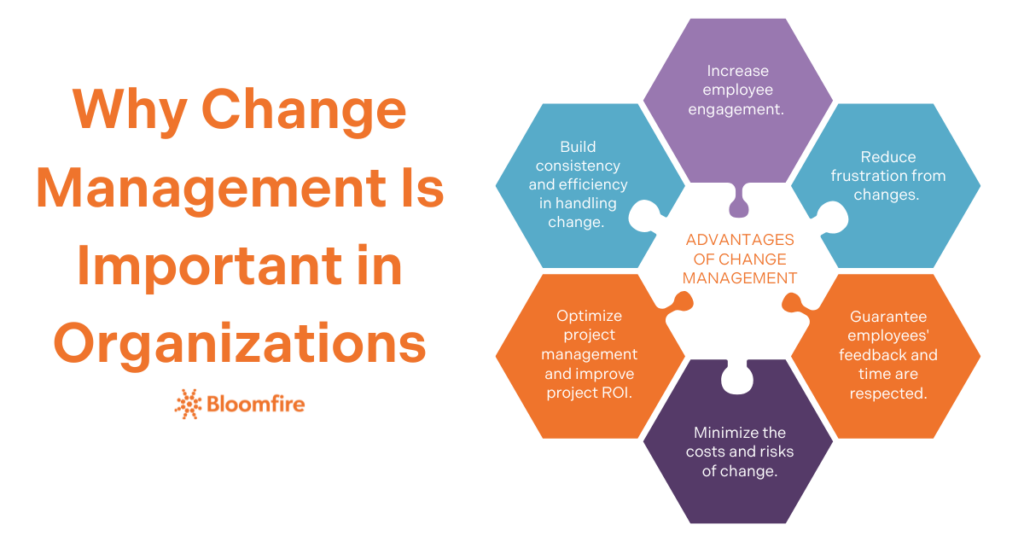The Importance of Change Management in an Organization

Businesses are constantly evolving, with the average company undergoing five or more significant, firm-wide changes in just the past three years. This rapid pace of change underscores the critical importance of change management in an organization, specifically in navigating transitions. As a result, changes are implemented effectively, and employees are supported throughout the process to minimize disruption and maximize positive outcomes.
Successful organizational change management fosters employee buy-in, ensuring they understand, commit to, and effectively navigate transitions. This proactive approach prevents lost productivity, reputational damage, and negative financial impacts resulting from poorly managed change. Below, we explore the critical need for and significant benefits of robust organizational change management.
How an Organizational Change Management Process Works
An organizational change management process consists of five steps: planning, preparation, implementation, monitoring, and evaluation. These steps lead an organization from its current state to a new desired one. The change management process is viable and effective when introducing new tech, rebranding, or restructuring your organization (just to provide a few examples).
Change typically affects the entire organization, and the change management process equips each employee with the necessary skills and tools to address the transition and succeed. It also involves setting expectations and ensuring everyone understands their role and responsibilities in this new stage.
Importance of Change Management: Why It Matters
Change management is the discipline that guides how you prepare, equip, and support employees to adopt change to drive organizational success. Effective change management allows organizational transitions to be smoother and less costly in terms of time and resources, which is more timely today than ever.
According to Accenture, businesses have faced an increasingly rapid pace of change since 2019. This acceleration is evident in the 183% surge in the rate of change over the past four years, with a further 33% jump in 2023.
Given this transformation rate, organizations highly value change management in executing transitions, especially as employees experience significant downtime during the process. A survey conducted by Gartner among 473 HR leaders found that 73% of employees are tired of change, and 74% of managers are ill-prepared to handle it. However, these issues can be addressed by properly planning and implementing any organizational change.
In addition, the importance of change management in organizations manifests in the following ways:
- Effective change and knowledge management can increase employee engagement.
- It reduces frustration with your operational and technology changes.
- It guarantees that employees’ feedback and time are respected.
- It minimizes the costs and risks of change.
- It optimizes project management and improves projects’ returns on investment.
- It builds consistency and efficiency in handling change as your organization scales up.
Despite the complexities, building a successful change management process is doable, especially if you leverage knowledge management and seamless sharing in the process. It requires significant effort, but you can succeed through consistency and commitment.

10 Major Impacts of Effective Change Management
Change management helps businesses evaluate, redesign, and implement new business processes. Organizational growth and improving business processes is a never-ending journey. The return on investment (ROI) of improved business processes will depend on the optimized process type. Nonetheless, the benefits of change management in organizations can reach the granular levels.
These ten specific impacts highlight the multifaceted effects of well-implemented change management strategies. From enhancing professional credibility to mitigating employee burnout, each benefit underscores change management’s integral role in nurturing a thriving, responsive, and forward-looking organization.
1. Ensures Consistent and Professional Approach
An organization that presents itself professionally gains credibility with its employees, customers, and prospective investors. A defined change management process helps businesses maintain professionalism by providing a consistent and repeatable approach to dealing with changes.
Best practices in change management involve transparent processes for planning, communicating, and executing changes. This minimizes ad hoc actions and promotes uniformity across the organization. It also facilitates knowledge sharing and the transfer of lessons learned, allowing organizations to refine their change management practices over time.
2. Minimizes Change-Related Roadblocks in the Organization
If not managed well, change can lead to new friction points as employees try to adapt to new processes, technology, or ways of working (or reject those changes outright). A change management plan will help identify and address potential friction points before they arise so the change can be rolled out as efficiently as possible. It achieves this through stakeholder analysis, identifying individuals or groups likely to be impacted and their potential concerns.
This foresight from change management allows for tailored information or data transmission strategies, addressing common workplace communication issues, anxieties, and misconceptions head-on. The plan also incorporates impact assessments, analyzing how the change will alter existing processes and pinpoint areas of disruption.
3. Establishes Better Trust Across the Organization
Smoothly handling changes as they arise can build employees’ trust in your organization. Employees want a workplace where drastic changes are managed effectively and communicated transparently. Using a knowledge management platform, you can share your planned change management strategies to boost employee morale and confidence in the company.
Moreover, uncertainty and speculation are reduced when leaders openly share the rationale behind changes, potential impacts, and anticipated benefits. Involving employees in the change process, soliciting feedback, and addressing their concerns demonstrate respect and value for their contributions. This consistent approach fosters a sense of shared understanding, reduces anxiety, and strengthens the belief that leadership is acting in the organization’s and its members’ best interests.
4. Increases Productivity and Adoption
A well-managed change process fosters a productive environment and accelerates adoption through strategic communication, training, and stakeholder engagement. When everyone understands the objectives of the transition or transformation, nobody is left in the dark about how they should carry out their roles during the change process.
For example, when a company implemented a new customer relationship management (CRM) system, change management initiatives included personalized training sessions and ongoing support forums. This resulted in swift user adoption and a noticeable increase in sales team productivity as they efficiently leveraged the new system’s capabilities rather than struggling with a poorly integrated tool.
Power Move: Documentation is a strong aspect of change management. From announcements to planning documents and standard operating procedures, employees can quickly review the knowledge guiding the process. To make this even more efficient, you should leverage a knowledge management system that is easily accessible to everyone in the organization.
5. Improves Employee Professional Development
Change management involves preparing your employees for other major and minor changes. It creates opportunities for skill enhancement as employees adapt to new processes or technologies, often including targeted training and mentorship programs.
For instance, during a restructuring that flattens management layers, a change management plan might include leadership development programs for newly promoted team leads. These cover cross-training initiatives, equipping individual contributors with broader skill sets for increased autonomy and responsibility. Such investment in employee growth cultivates a more agile and capable workforce poised for future organizational challenges.
6. Enhanced Risk Management
Effectively managing change fortifies risk management within organizations. It provides a structured framework for anticipating potential disruptions and vulnerabilities associated with transformations. As a result, it speeds up decision-making, similar to the impact of other business principles like knowledge management.
Consider an organizational reshuffling involving department restructuring. Change management principles would compel leaders to assess the potential impact of this shift on team dynamics, knowledge transfer, and operational continuity before the change occurs. For instance, if a high-performing team is split and its members are redistributed, change management would prompt an evaluation of the risk this poses to project timelines or overall team morale.
7. Reduces Employee Resistance
Barriers to organizational change can manifest in several forms: employee resistance, technological constraints, budget constraints, and a lack of executive support. Employee resistance occurs when an employee opposes change by not participating or making contrary choices, hindering success, morale, and productivity.
Change management equips managers to facilitate shifts in the workplace. It also fosters a sense of ownership, transforming employees from passive change recipients to active participants. It demonstrates respect for employee perspectives and reduces resistance as individuals feel heard and valued throughout the transformation.
Simplify Change Implementation
Learn how Bloomfire eases organizational changes with seamless implementation.
See How it Works
8. Improves Cost Management
Poorly managed projects can quickly exceed planned budgets, especially when they take longer than initially anticipated. On the other hand, effective change management can help with cost management by anticipating and preventing any delays caused by employee or leadership resistance. It also minimizes costly rework, delays, and disruptions that can inflate project budgets.
For instance, if Company A acquires Company B, change management will identify redundancies in IT systems early on. This action will streamline the integration process and avoid the expense of maintaining duplicate systems for longer than necessary.
9. Build Better Employee Burnout Control
Low morale can harm your organization’s functioning and growth, especially if your employees are tired from dealing with organizational changes. Change management helps you communicate changes and roll them out smoothly so employees experience minimal disruptions and understand the long-term benefits of the change.
Furthermore, when organizations implement changes thoughtfully, individuals feel less like uncontrollable tides are sweeping them along and more like active participants in a shared journey. This sense of agency reduces the stress and uncertainty that often accompany change, mitigating feelings of overwhelm and exhaustion.
10. Surefire Goal Alignment
Change management acts as a bridge, connecting the desired future state with the current reality. This involves clearly articulating the change’s vision, explaining its rationale, and describing the benefits it offers each stakeholder group. Individuals understand how their roles contribute to the overall objective through consistent dialogue and engagement.
For example, during a corporate restructuring, the change management team clarifies the new organizational structure, defines reporting lines, and outlines revised roles. This prevents confusion, reduces anxiety, and empowers employees to adapt quickly. As a result, it ensures that the restructuring achieves its intended goals of improved efficiency and resource allocation. It transforms a potentially disruptive event into a coordinated effort toward a shared vision.
How Knowledge Management Helps
Any change management initiative requires clear and consistent communication across the organization. While your team may use several different communication channels, one tactic that can help is using a knowledge management platform to centralize updates and information about the change.
Knowledge management fuels successful change management through the strategic capture of knowledge and big data and the analysis and distribution of pertinent information. Critically, it fosters a culture of organizational learning, transforming each change initiative into a valuable opportunity for growth. The accumulated wisdom derived from successes and setbacks becomes institutional knowledge. Knowledge management creates a dynamic feedback loop that continuously refines and strengthens an organization’s capacity for future change.
When using any type of knowledge management system, information related to change management should be prominently displayed on the platform (e.g., pinned on the homepage) to stay at the top of your employees’ minds. It could also be pushed out through notifications (both on the platform and via email or an integrated chat app like Slack or Microsoft Teams).
Giving all employees on-demand access to this information can help keep teams aligned during the period of change and ensure no one misses important updates, ultimately helping the change to go smoothly and start benefiting your organization sooner.
Leveraging Change Management Effectively
The importance of managing change in organizations that evolve into industry leaders cannot be understated. However, a key element often overlooked in change management is creating a learning loop. Whether successful or not, each change initiative provides valuable data for refining future change strategies. This is where knowledge management becomes essential.
Therefore, to ensure a successful change management plan, maximize the use of a knowledge management system tailored to your organization, such as Bloomfire.
Note: This blog was published in January 2023 and was most recently updated and expanded in March 2025.
A KM System for Organizational Changes!
Keep your change management plan in one space for quick access.
Talk to an Expert

Digitalization and Digitization of Business Processes (+How They Drive Digital Transformation)

What Is Business Digitization? A Comprehensive Guide to Modernizing Your Operations

How Proactive Business Leaders Are Preserving Their People’s Knowledge

Start working smarter with Bloomfire
See how Bloomfire helps companies find information, create insights, and maximize value of their most important knowledge.

Take a self guided Tour
See Bloomfire in action across several potential configurations. Imagine the potential of your team when they stop searching and start finding critical knowledge.
